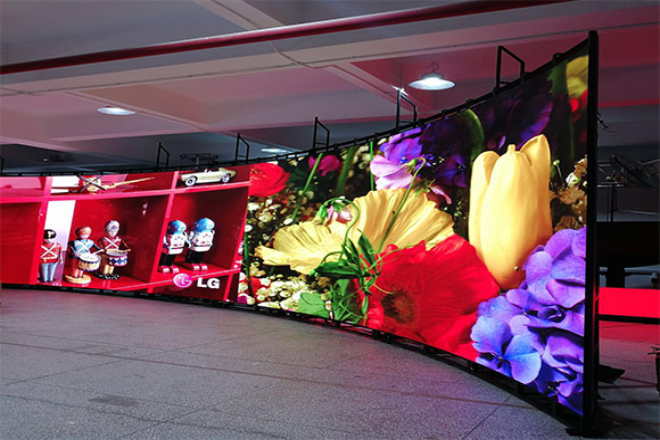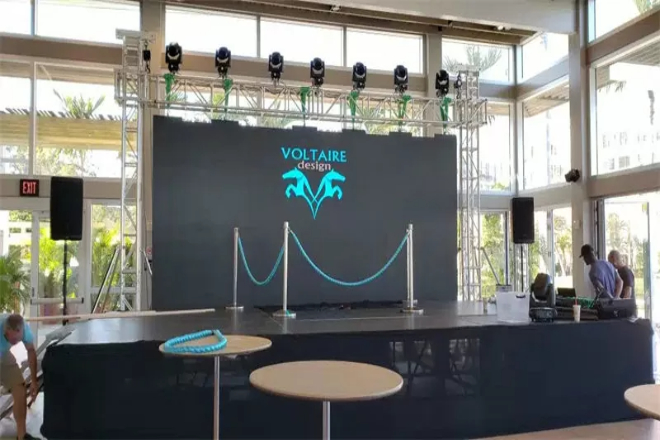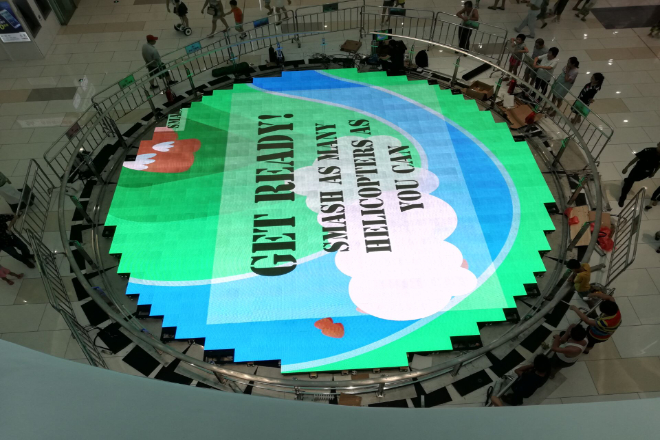Introduction

Afficheurs LED are increasingly used, and the use environment is becoming more diverse.
Environmental factors such as humid air in some areas have gradually shown their impact on the performance of LED screens.
In particular, whether humid air can cause short circuits on LED screens has become a matter of concern.
This article will explore the characteristics of humid air and its impact on electronic equipment, reveal the mechanism by which humid air causes short circuits on LED screens, and propose corresponding prevention and response measures. Let’s take a look.
Table des matières
1. What is the impact of humid air on electronic equipment?

Humid air has a huge impact on electronic equipment, especially LED displays. Let’s talk about this.
Did you know that a humid environment is a “nemesis” for the metal parts of LED displays, such as the pins of the lamp beads, the solder joints on the circuit board, and the frame?
These metal guys are prone to rust and corrosion after being in humid air for a long time, becoming like crispy cookies, and they may break if you are not careful.
As a result, the lamp beads on the display start to “strike,” either not lighting up or flashing, which makes people dizzy and unhappy.
Let’s talk about insulating materials. The thin circuits and wires in the LED display must be separated by insulating materials; otherwise, the current will run around.
However, when humid air comes, these insulating materials are like sponges that absorb water and become less insulating.
When the current sees that there is a “shortcut” to take, it “whoosh” rushes over, causing a short circuit. In this way, some strange bright spots or dark blocks may appear on the display screen, which makes people confused.
In addition, humid environments are particularly suitable for mould growth. These moulds look dirty and secrete some acidic substances.
Once these things touch the circuit, it will be bad. The circuit will be corroded, and the life of the display screen will be greatly reduced.
Speaking of the key components of the LED screen, the LED lamp beads are “squeamish.” Although the outer layer of packaging material looks strong, it is not airtight.
Once water vapour slips in, especially the halogen-containing water vapour, once the power is turned on, some “small friction” will occur.
If it is light, the lamp beads will become dim and not bright; if it is heavy, it will not light up directly, or the whole string of lights will light up, like a play.
The driver circuit board is also a “wet ghost.” This circuit board is like the “commander” of the LED screen, responsible for commanding all the lamp beads to light up and change colour.
However, once it encounters humid air, those thin lines, solder joints, and small electronic components are prone to rust and corrosion. If the solder joints are not in good contact, the circuit board may “go on strike” or simply stop working.
In addition to the lamp beads and circuit boards, the frame and connecting wires of the LED screen are also afraid of moisture. Although the frame is made of metal and is quite strong, it will rust and become shaky if it is exposed to moisture for a long time.
Once the connecting wires are exposed to moisture, they may leak electricity or even short-circuit, which is dangerous and may even cause a fire.
Therefore, we must be particularly careful when storing, transporting and installing LED screens.
They must be packed in moisture-proof bags and moisture-proof boxes, and some desiccant must be added to ensure that they are dry and cool. When installing, you must also choose a dry and ventilated place to prevent it from getting damp.
You must also check and maintain it regularly to see if there are any problems and repair them in time.
Otherwise, once it gets damp, the LED screen may have various problems, which will make people upset and have to spend a lot of money to repair it. We must protect these “squeamish ghosts” well and let them serve us for a long time.
2. The mechanism of humid air causing LED screen short circuit
The effect of humid air on LED screen short circuits is actually quite interesting. It mainly causes damage through two “troublemakers” – water condensation and increased conductivity.
Next, let’s talk about this process and give an example of how moisture “slips” on the circuit board and where it may cause a short circuit.
1). How humid air causes LED screen short circuit
1.1). Moisture condensation:
Think about it: when humid air meets a cold LED screen, it will form small water droplets, just like when we breathe on the glass in winter. If these small water droplets have nowhere to go, they may slip into the screen, especially in those small gaps.
Once the water droplets enter, they may touch the wires on the circuit board. If the water droplets are large enough or deep enough, they may connect the wires that were originally unconnected, and a short circuit will occur.
1.2). Increased conductivity:
There are many small water droplets in the humid air. These water droplets are attached to the circuit board, just like a layer of “water film” on the circuit board.
This “water film” makes the circuit board more conductive, just like the originally non-conductive place suddenly becomes conductive.
In this way, the wires that should have been separated may secretly leak electricity. If there is too much leakage, a short circuit will occur. Especially those places that have some minor problems are more likely to have problems.
2). The “slipping” path and short-circuit point of moisture on the circuit board
2.1). “Slipping” path:
Moisture usually slips in from the corners of the circuit board. Those small gaps and holes are good places for it.
After entering, the moisture “slips” along the gaps between the wires or insulation layers, which may go along the wires or sideways.
If the component has gaps in the package or pins, moisture may enter again.
2.2). Possible short-circuit points:
- Between solder joints:
The solder joint is where the component and the wire are connected. If the insulation layer is broken or moisture enters a short circuit may occur between the solder joints.
Line intersections: Sometimes there are lines on the circuit board that cross but are not connected. If moisture accumulates there, it may connect the originally unconnected lines.
- Between component pins and lines:
If the insulation layer between the component pins and the wire is broken or moisture enters a short circuit may also occur. Especially those components with long pins or packaging problems are more likely to have problems.
For example, if an LED screen is placed in a humid place for a long time, the water vapour in the air will slowly condense on the screen and then enter the circuit board. There is a solder joint on the circuit board.
Because it has been used for a long time or there were some minor problems when it was made, the insulation layer is not very good.
When moisture enters the vicinity of this solder joint, the solder joint is connected to the wire next to it, and a short circuit occurs. At this time, the LED screen may not light up, flicker, or simply stop displaying.
So, we have to find a way to keep the LED screen in a dry place, ventilate it regularly, use a dehumidifier, etc.
When making an LED screen, we must also consider moisture-proofing, use moisture-proof materials, and do a good job of sealing so that the LED screen can be used longer and more reliably.
3. Prevention and countermeasures for humid air on LED screens

The prevention and countermeasures for humid air on LED screens are actually like protecting our beloved electronic products, which requires careful and meticulous work.
Next, let me talk about how to prevent LED screens from short-circuiting due to humid air and how to maintain LED screens in humid environments so that everyone can easily get started.
1). Preventive measures
1.1). Choose moisture-proof materials and put “waterproof clothes” on the screen:
The key components of the LED display, such as the lamp beads and circuit boards, must be made of materials with good moisture-proof performance.
Just like we look at the fabric when choosing clothes, materials with good moisture-proof performance are like waterproof fabrics, which make it difficult for water vapour to penetrate.
The packaging material of the lamp beads must be selected with good sealing so as not to allow water vapour to get in.
The circuit board can also be coated with a moisture-proof coating, just like putting a layer of “waterproof clothing” on the circuit board to protect it from moisture.
1.2). Strengthen ventilation and let the screen “breathe” fresh air:
The place where the LED display is installed must be well-ventilated, just like we need fresh air. Good ventilation can help water vapour evaporate quickly and reduce environmental humidity.
You can install a few fans around the display or turn on the air conditioner to let the airflow. Especially in the humid season, more ventilation is needed to keep the screen dry.
1.3). Dehumidification equipment to help reduce humidity:
If the environment is too humid, you have to ask for dehumidification equipment to help.
Dehumidifiers and air conditioners can be used in dehumidification mode to reduce indoor humidity and give the LED display a dry working environment.
Outdoor display screens can also consider installing dehumidification equipment to cope with rainy seasons.
1.4). Sealed installation, don’t let water vapour take advantage of opportunities:
Outdoor LED display screens must be well sealed when installed and don’t let rain or moisture get in. The borders and interfaces must be sealed with waterproof rubber rings or sealing strips to ensure that there is no risk of error.
1.5). Regular inspection and maintenance, don’t wait until problems occur before regretting:
The display screen must be checked regularly to see if there is any condensation or water seepage.
Dust and debris must also be cleaned to keep the display screen clean, and heat dissipated well. Just like our regular physical examinations, early detection and early resolution of problems.
2). Maintenance recommendations and best practices
2.1). A dry environment is king and humid places should be avoided:
Try to avoid installing LED display screens in humid, rainy or condensation-prone places. If there is really no other way, moisture-proof measures must be taken, and dehumidification equipment and ventilation must keep up.
2.2). Turn on regularly to let the screen “move”:
In a humid environment, turn on the LED display screen regularly to let it work for a while, and use the heat generated by the screen itself to evaporate some of the water vapour.
Just like we need to get up and move around after sitting for a long time, the screen also needs to “move around”.
2.3). Desiccant help, storage and transportation are not a problem:
When the display is stored or transported, you can put some desiccant inside to absorb moisture in the air. The desiccant must be replaced regularly to maintain its moisture absorption performance.
2.4). Water seepage must be dealt with without delay:
Once the display is found to be leaking, the power supply must be cut off immediately, and professional maintenance personnel must be found to inspect it.
When dealing with water seepage, it is necessary to ensure that the inside of the screen is completely dry before it is powered on. Do not cause greater losses due to laziness or negligence.
2.5). Professional personnel must be trained, and maintenance skills must be mastered:
The personnel responsible for the maintenance and operation of the LED display must receive professional training to understand the harm of humid air to the display, as well as the preventive measures and maintenance methods.
Just like when we learn to drive, we must master the skills before we can go on the road.
In short, it is necessary to be careful and meticulous in preventing the LED display from short-circuiting due to humid air.
It is essential to select moisture-proof materials, strengthen ventilation, use dehumidification equipment to help, seal the installation, and conduct regular inspections and maintenance.
Maintaining LED screens in a humid environment also requires methods.
Keeping the environment dry, turning it on regularly, using desiccants, dealing with water seepage in a timely manner, and training professionals are all key. Only in this way can our LED display screens serve us for a long time.
4. Conclusion
This article analyzes the basic structure of LED screens, the characteristics of humid air and its impact on electronic equipment, and reveals the mechanism by which humid air causes LED screens to short-circuit.
We recognize that humid air poses a potential threat to LED screens, and effective prevention and response measures need to be taken.
Enfin, si vous souhaitez en savoir plus sur les écrans LED, veuillez nous contacter.
